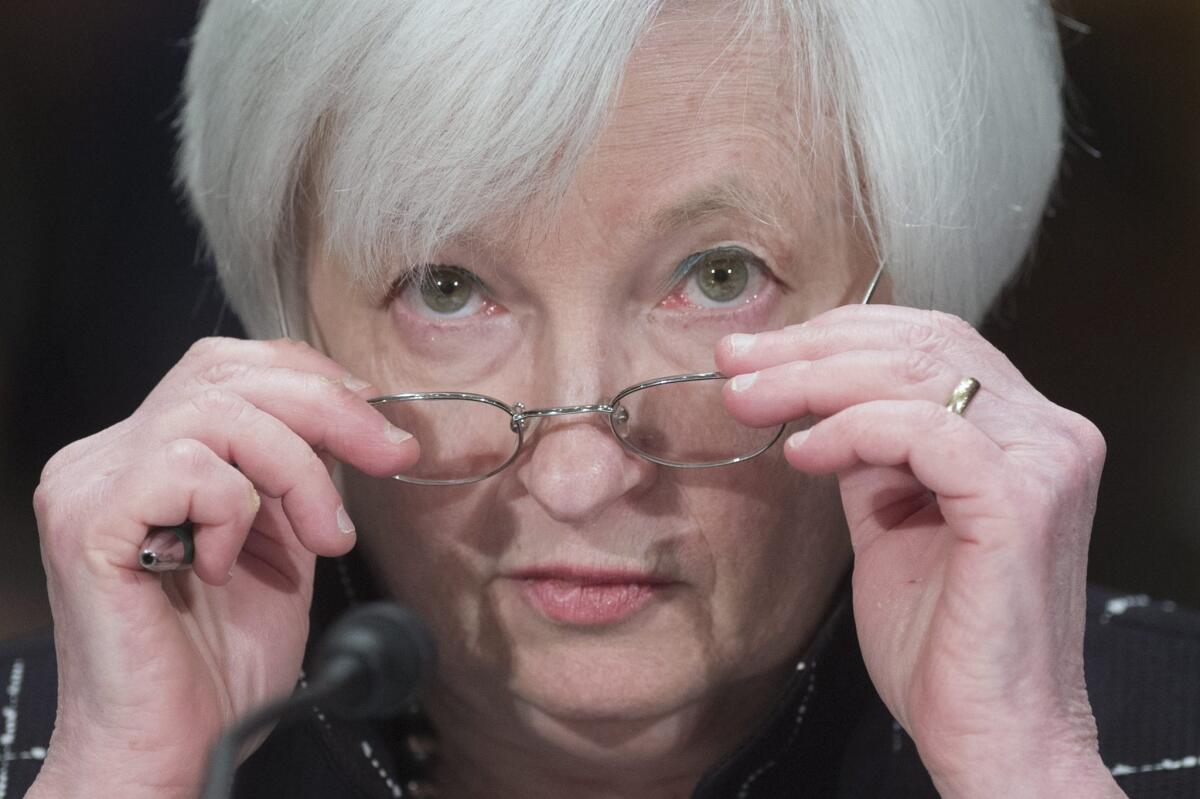Some countries are using negative interest rates to fight slowdowns: Is the U.S. next?

Federal Reserve Board Chairwoman Janet L. Yellen appears before the Senate Banking, Housing and Urban Affairs Committee hearing on Capitol Hill.
Reporting from Washington — First Europe. Then Japan. Could the U.S. be next to turn to negative interest rates as a way to fight economic doldrums?
That question was raised last week by lawmakers quizzing Federal Reserve Chairwoman Janet L. Yellen, who voiced skepticism.
But the prospect of negative rates — in which depositors pay banks for the privilege of stashing money rather than earning interest — isn’t as far-fetched as it once was.
MORE: Get our best stories in your Facebook feed >>
Negative interest rates for certain funds already is the new normal in some of the most advanced economies. Since 2012, central banks in Denmark, Switzerland, Sweden and the 19-nation Eurozone have cut rates below zero, meaning commercial banks must pay them to park the cash they hold for clearing purposes and to meet minimum reserve requirements.
Last month, the Bank of Japan joined the club, adopting a minus 0.1% rate on commercial bank deposits.
These central banks are turning to negative interest rates — once thought to be an economic and political impossibility — to provide an additional instrument in their toolbox for fighting off recessions and economic slowdowns.
By charging financial institutions to hold their money, central banks hope sub-zero rates will prod private lenders to make more loans to businesses and consumers, thereby stimulating the economy.
The tactic also could be used to combat the threat of deflation, a potentially crippling condition of falling prices for goods and services that can lead to hoarding cash, putting off purchases and rising real debt payments. So far, negative rates generally haven’t spread to ordinary depositors, although some European banks are charging corporate customers for safe-keeping their money.
Experts have long predicted that consumers, particularly in America, would never accept negative rates.
“It would scare the American public to death,” said Chris Rupkey, chief financial economist at Union Bank in New York, who said he doesn’t see the economy unraveling to the point where the Fed would need to resort to negative rates.
It was assumed that if rates went negative, depositors would simply withdraw their money and put in under their mattresses. It might also lead to new and unpredictable behavior, such as businesses and consumers opting to pay for goods and services upfront or in advance for several months, rather than hold money in bank accounts charging them a penalty.
But others predict depositors likely would swallow the new costs, albeit reluctantly, just as they have accepted other kinds of banking charges and fees.
And with interest rates currently so low, ordinary bank customers already are seeing a negative interest on their deposits after adjusting for inflation. The latest annual inflation rate through December was 0.7%, but a one-year certificate of deposit has paid an average interest of less than 0.3% since November 2012, according to Bankrate.com.
For consumers like Shukry Cattan of Santa Ana, the idea of negative rates doesn’t sound so crazy since he’s grown accustomed to expecting little, if any, interest on deposits. The 33-year-old, who works at the UCLA Downtown Labor Center, says he uses his savings account simply as a way to hold money temporarily for vacations or big purchases.
“I feel like I’m paying more than I should keeping an account,” he said of having to maintain a $300 balance or pay a fee. “We’re also used to paying money for ATMs. It sounds preposterous, but we’re conditioned now to accept it. You feel like you’re stuck. The alternative is to put it under my mattress.”
How well negative interest rates have worked is debatable, but most economists think they’ve had some success in Europe. Lowering rates below zero have helped to stem the appreciation of Swedish and Swiss currencies and significantly push down the value of the euro against the dollar, a boost for exporters in the single-currency zone.
“It’s certainly the case the European Central Bank avoided outright deflation,” said Jacob Funk Kirkegaard, a Europe economy expert at the Peterson Institute for International Economics.
In the U.S., where the economy is stronger but also facing questions about its future, the central bank so far is moving in the opposite direction.
Following solid job growth and other positive signs in the recovery, the Fed lifted rates in December after holding them near zero for seven years. Today, the Fed’s benchmark short-term interest rate is effectively 0.38%, and commercial banks still pocket money for parking their reserves with the institution.
Unless the economy weakens significantly, many analysts expect Fed policymakers to slowly raise rates a little further, not cut them.
But amid the recent market turmoil, fears surrounding China’s slowdown and a plunge in oil prices, there are growing concerns about the strength of the U.S. economy and what ammunition the Fed might have to combat a recession.
In 2010, after the Fed had lowered rates as far as it could in response to the Great Recession, central bankers considered going negative, but rejected the idea, Yellen said. Instead, it launched on a policy known as quantitative easing, in which it attempted to increase the money supply by purchasing government securities.
Asked about negative interest rates earlier this month, Yellen said that the Fed is studying the issue and that the idea is not “off the table.” At the same time, she doubted such a step would be needed.
Even so, in this year’s stress test of banks — in which the Fed requires banks to submit a simulation of how they might handle adverse conditions — some 30 large banking firms were asked to estimate what could happen should rates be cut to below zero.
Some bank economists and other analysts think negative rates are a terrible idea. They blame the recent market turbulence partly on central bank policies to roll out negative rates.
Bank company stocks, particularly in Europe, have been hammered as investors worry about future profit margins. Because most banks have been reluctant to pass along the negative rates to their customers, their balance sheets are starting to take a hit.
The ECB could lower its deposit rate, now minus 0.3%, further into negative territory next month. But most doubt that will spur more economic activity through greater lending and investment.
“The demand side has been the problem over the last few years” in the U.S., said Jim Chessen, chief economist at the American Bankers Assn. “The issue is confidence of businesses wanting to expand against a backdrop of weak growth. That’s been the issue, and it doesn’t improve if rates go negative.”
While Chessen doesn’t see negative rates for the U.S., he said major banks are taking the matter seriously. “It’s very much front and center for large banks to consider the consequences of it,” he said.
Frank Sorrentino III, chairman of ConnectOne Bank, a New Jersey-based community lender with $4 billion in assets, said he was less worried about a public backlash against negative rates because any such debate would likely be overshadowed by the dire economic problems that would need to be present to force the Fed to take such an unprecedented a step.
“For there to be negative interest rates,’’ he said, “there would have to be a hell of a lot of problems that are more important.”
MORE BUSINESS NEWS
Tristan Walker’s Bevel is making shaving better for men of color
Why airlines’ frequent-flier programs are now rewarding big spenders
Why Apple’s fight with the FBI could have reverberations in China
More to Read
Inside the business of entertainment
The Wide Shot brings you news, analysis and insights on everything from streaming wars to production — and what it all means for the future.
You may occasionally receive promotional content from the Los Angeles Times.










